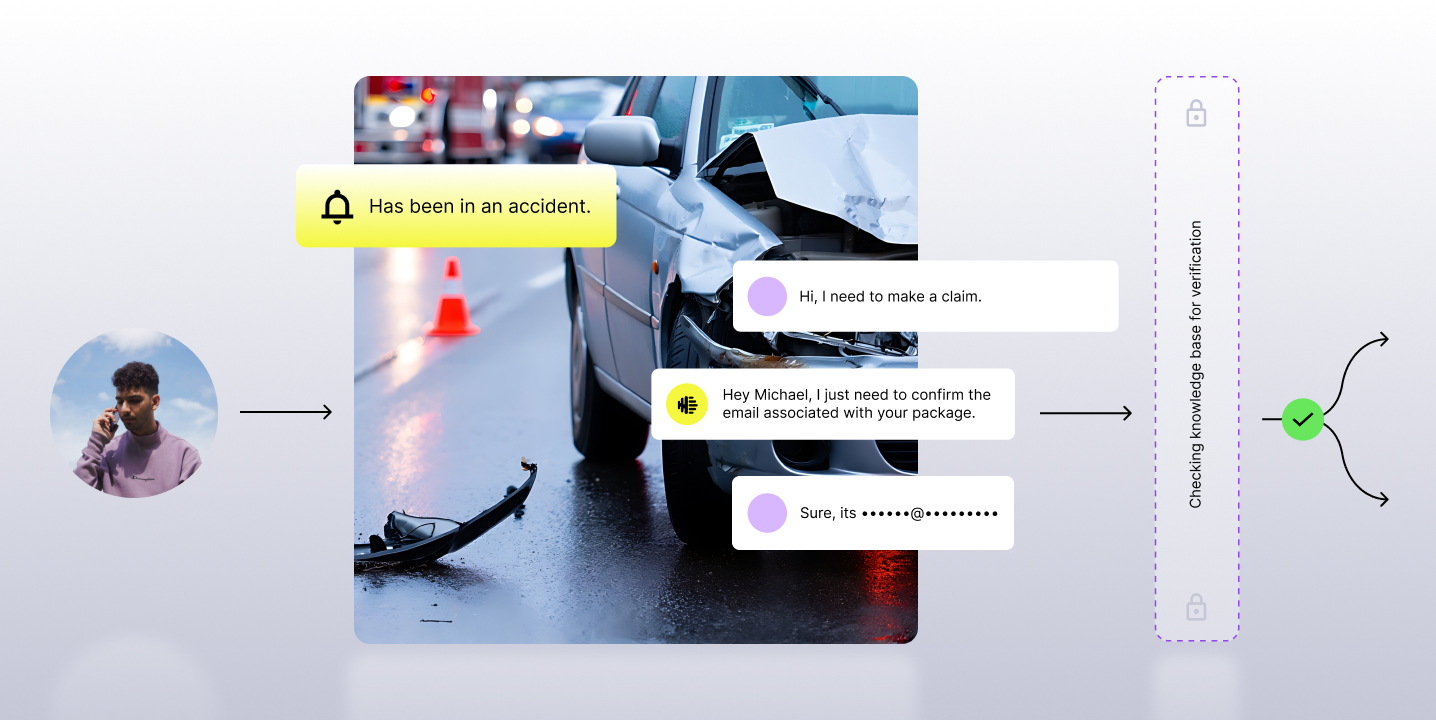According to the Post-pandemic Contact Center Report, 54% contact center leaders are looking to automate workflows to improve agent productivity and time management.
As the world takes steps towards reopening, contact centers are experiencing major revamps in how they approach new expectations in customer experience (CX). As a result, future trends are forward-thinking, technology-focused and highly data-driven.
In this article, we’ll present five trends set to transform contact centers post-pandemic. These five inevitable trends are:
- Adopting hybrid work environment
- Sentiment analysis on customer interactions
- Omnichannel integration
- Video first customer experience
- Future of CX metrics

[I] Adopting hybrid work environment
This one’s a no-brainer.
Post-pandemic, many enterprises are transforming their current processes to embrace a hybrid workforce. At Lifesize, we see this mindset shift when interacting with our enterprise customers.
Conversations have evolved from measuring KPIs to product configuration that’s conducive to hybrid work environments.

A great example is the telehealth industry, one of the many industries Lifesize caters to. The defining use case for years was customers calling in to schedule appointments, but today it’s more than that— it’s consultations, follow-ups, emergency requests and more.
All of these require a video-first experience to build trust, transparency and safety.
But to combat the work from anywhere paradigm, it is important to facilitate an immersive experience between an agent and customer.
With AI, cloud, video and digital CCaaS solutions available today, it’s now possible to replicate your floor energy into a hybrid work environment and build a supervisor-agent-customer collaboration model.
As a leader in your organisation, it’s important to provide the agents with tools to make their lives easier, enable them to handle exponential increase in call volumes, and bring transparency between teams.
[II] Sentiment Analysis
For contact centers, it is important to understand unmet customer needs, frustrations, or simply how the customer is feeling, in the moment.
It’s applied by transcribing and analyzing millions of recorded audio calls using speech recognition and Natural Language Processing (NLP) on a deeper level and automatically detecting positive, negative, or neutral interactions on calls.
This data is used by CX teams to instantly identify unmet customer needs and new opportunities to improve service quality.
With customer interactions surging exponentially in the past year, sentiment analysis has become a key factor in building a successful contact center. It is also an important tool in your QA and coaching teams’ toolboxes
Let’s break this down into two parts: sentiment and tonality.
1. Sentiment
At Lifesize, queries on sentiment analysis have increased significantly.
The qualities of a top performing agent can be attributed to how well they identify and manage a customer’s sentiment in real-time, thus delivering superior experience.
However, with remote or hybrid work environments, how does one coach every agent to deliver a consistent customer experience or replicate the contact center floor energy?
Sentiment analysis bridges this gap. Instead of trying to gauge and “guess” a customer’s emotions, sentiment analysis frees up the agent to solely focus on resolving a customer’s query.
As more data is collected, it is easier to determine the overall customer sentiment across the ”hybrid work” floor. The accuracy of this data is unparalleled pushing the supervisors to replicate the floor.

2. Tonality
A lot of CCaaS solutions today simply transcribe the interactions and fall short of understanding the essence of tonality.
Tonality determines what the customer has said and how they have said it.
Today, technologies using AI, NLP, and speech analytics, understand how a customer has expressed a certain statement and then drive insights to improve customer experience.
Using the tone of speech, the technology can pinpoint every instance where the customer responded negatively to the agent on the call. Armed with this data, coaching, evaluating and giving focused, constructive feedback can power up the CX game in hybrid work environments.
The biggest advantage to using AI is that it is scalable. Contact centers no longer have to rely on their top performers to deliver a great experience, but can coach every agent to deliver amazing and consistent experience.
[III] Omnichannel integration
Before we discuss omnichannel, let’s address the state of voice calls as of today.
Voice still remains the biggest player in customer interactions and it is only going up. Our customers are also interacting from anywhere, aren’t they?
For example, they’re not walking into stores or a doctor’s office anymore. So, to address their complex and in-depth queries, voice is the channel of choice.
As the questions evolve to higher levels of complexity, voice calls will remain the most preferred channel for resolutions. Undoubtedly, it is the fastest way to breed customer loyalty with the brand.
But not all questions are complex and need voice support like checking account balance or an order’s delivery date. For such trivial, simple queries, omnichannel customer experience is a lot more efficient.
For the uninitiated, omnichannel customer experience is made up of individual customer touch points, over a variety of channels like call, email, social media, website and more, allowing customers to pick up where they left off on one channel and continue the experience on another.
Omnichannel is golden only if executed well.

A strong, well integrated omnichannel workflow has the ability to free up time and attention of every role in the organization— leaders to build accurate data reports, quality analysts to focus on accurate evaluations, supervisors to focus on coaching agents, and finally, agents to deliver a great customer experience.
For a successful workflow, it’s absolutely essential to seamlessly integrate all the support channels. Here’s why.
1. Great customer experience:
When you expand on the concept of bringing omnichannel into your contact center, it’s crucial to identify and operationally put every cog in place.
Historically, it’s a little harder to incorporate email and other channels with voice, but with the right integration tools, omnichannel is the ultimate CX powerhouse.
At Lifesize, our customers with integrated digital channels in the standard operating procedure perform much better than contact centers choosing to operate the different channels in silos.
On paper, the siloed method shows clarity— assign a few agents to handle incoming queries on each channel. But customers tend to easily switch gears when interacting with a brand.
Customers' expectations are— “I want a solution faster, sooner, better, no matter what.”
So, as they switch from email to social to voice, the siloed approach starts to crumble. With no visibility into the customer’s previous interactions, multiple agents simultaneously handle the same query leading to wasted time and increased costs.
But when all the elements in omnichannel are operationally stitched together, it is easier to track the entire history of the conversations and accordingly approach the customer. This integration gives visibility to the agent into the customer’s history, frustration, query and resolution bottlenecks.
2. Agent performance and coaching
Operationally converging digital channels with voice using cloud and AI-based solutions gives transparency into an agent's performance. It easily tracks all interactions— voice, email, social, website chat, etc.
Analysts and supervisors use these solutions for 6 to 8 hours in a day. It is essential to automate tedious workflows, reduce redundancy, collect accurate data and build faster, efficient operations.
For omnichannel, it’s important to prioritize user experience— agents, analysts, supervisors and coaches— by integrating with solutions on user onboarding, customer success and data accuracy. If these pieces aren’t built into cohesive workflows, it’ll promote hesitation during product adoption.
So, what constitutes strong omnichannel workflows?
Strong omnichannel workflows use every data point from every agent interaction to focus on accurate tracking of agent performance and coaching.
Every CX interaction is important for evaluation by quality analysts(QA), the data from which is used to coach agents.
By bringing in every component together in an automated workflow, every interaction can be measured to build a faster feedback loop mechanism.
A well-integrated omnichannel workflow can catch areas of improvement in near real-time, leading to faster, accurate and efficient tracking of agent performance and coaching.
But considering where the contact center industry is today, it’s still a crawl-walk-run process. A lot of our customers still use the batch process— analyze a few samples to build their coaching and quality programs on this skewed data.
As more customers are building CX on other channels, it’s only time before the industry adopts omnichannel integration.
That’s the future of the contact center industry.

[IV] Video first customer experience
Lifesize has pioneered video chat because we strongly believe that using video earlier in customer interactions provides an immersive experience.
It is a great way to improve collaboration as it automatically engages the cognitive capabilities of the customer.
There are certain verticals like telehealth, education and financial services that use videos to increase an agent’s ability to effectively interact with the end customer to provide an enriching and immersive experience.
Instead of slamming agents with process flows to control customer interactions, agents need to be empowered with the right tools and prompts to drive the overall conversation towards the best outcome.
You take the technologies that your company is bringing, add immersive video experience to it and it’s truly pushing the boundaries of creating a personalised experience for a customer.
[V] Future of CX metrics
With rapid adoption of hybrid work environments, call center sentiment analysis, real-time agent performance and coaching, omnichannel, and video CX, does the future of contact center metrics change?
Historically, CSAT has been the central metric to measure the success of a contact center. Of course it's important but the turnaround time for measuring CSAT is relatively slow.
As more contact centers adopt AI, speech technologies, cloud integrations and real-time feedback mechanisms, it’ll be easier to build a holistic, accurate picture on the executional success of the workflows and customer sentiments without waiting for a direct customer feedback.
Qualitatively, contact centers today are less transactional-based and more outcome-based.

For example, an outcome could be a successful telehealth session, an educational session or a simple support call and if we can drive metrics to measure these outcomes, that’s where the future is.
So, if there were 100 calls and if let’s say 80 of them met the desired outcome, it's a huge win. To even reach this level of sophisticated metrics, it’s impossible to measure and analyze interactions via batch process.
Average handle time, first call resolution, and CSAT are very popular metrics. You send a survey and 9 out of 10, or 10 out of 10 times, it can probably tell you if the customer was happy or not. Any metric that measures customer happiness will always be relevant.
But with newer technologies, it will be easier to supplant these metrics with key measurable outcomes like—
Did the customer get relevant health advice?
DId the customer successfully purchase the right product?
So, how do you measure handling of the call and whether it successfully resolved the query?
Answer: AI.
By infusing AI and automation within your current workflows, any contact center can analyse 100% of the interactions at a higher transcription accuracy. The data is so accurate, that identifying tactics to deliver superior CX becomes superior. Even without an annual NPS, organisations can easily change strategies on the go.
———————————————————————————————————————————————————————————
In conclusion, for contact centers to deliver amazing, consistent and outcome-based customer experiences, it’s important to build adaptable workflows using the right technology.
A solution that enables adaptability and gets your entire workflow on a single window, enables your agents to adapt from anywhere and anytime, a platform that embraces omnichannel operationally, will prove to be a huge advantage for any companies looking to transform their customer experience.

.png)















